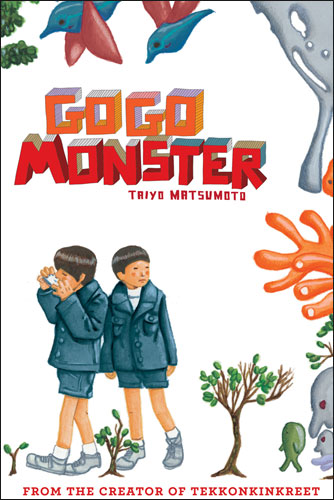
GoGo Monster
"There's a face in the water drop…"
Yuki Tachibana is in the first grade. He doesn't have many friends, only the gardener and one of the "Others," who Yuki calls Super Star. A new Transfer student named Makoto Suzuki becomes the only student in Yuki's class that actually talks to him, and eventually gets into his mind and brings him to reality.
Highlights
The "Others" have been multiplying, and they seem to be restless. Yuki has noticed this, and he's rather worried. Meanwhile, in the real world, a nearby school has been closed, with rumors that the principle hung himself. Four transfer students from that school have been sent to Yuki's class. Makoto is given the desk next to Yuki's. At first, the two don't really interact except when they are sitting at their desk. As the school year progresses, the two become friends, but Yuki is worried that the "Others" are getting mad at him. Unfortunately, Makoto can't see the "Others" so he can't necessarily understand what Yuki is getting at. "Super Star" is the Other that Yuki named, who is supposed to be the boss. He's been talking to Yuki less and less, and Yuki, who loves to garden with the groundskeeper, has been having trouble keeping his garden alive. This is hard for Yuki to deal with, but he has the reassurance of Makoto if so desired.
There is a side story that takes place at the same setting and eventually merges with the main story. IQ is a couple of grades above Yuki, but he is still a social outcast. This time, he happens to be extremely intelligent, so much so that good high schools have sent application requests to him. But the one ultimate deciding question for IQ is "Can I wear my box there?" See, IQ wears a box over his head with one eye hole, and he spends most of his time with the rabbits at the school. The rabbit cage is in the garden, so Yuki and IQ become well known to each other. One day an all white rabbit that is precious to IQ goes missing. IQ quickly loses his sanity.
Then there is the fourth floor. It isn't used because the school's attendance rate is too low to use all the classrooms. Rumors have been going around about the fourth floor; some say it's haunted, while Yuki believes it to be a hiding place for the Others. At the climax of the story, IQ has become completely insane, and thus he tries to cross over to the Other's side. Yuki, who has become terribly depressed, also tries to cross, but Makoto discovers their plot and tries to stop Yuki. Now it is up to Makoto to save Yuki and IQ from the possible devastation of a human living in the Other's land.
Overall
So much happened, but very little was actually said. The art is rather sketchy, making it hard to get into the meaning of the story. Later on, the art becomes better, in a way, going along with the progression of Yuki's thoughts. After you get accustomed to the artwork, you then have to decipher what is going on. Some of the panels seem to be pointless with no explanation, but it goes with what Yuki is seeing. The whole book is rather abstract and pretty much pointless, but towards the end, a real coherent plot emerges. There is no definition of what is real and what is Yuki making up, which, I realized, leads up to the climax. This also adds depth to Yuki's, Makoto's, and IQ's character. The way that each treats the Others is very different: from complete devotion, to general acceptance, to disbelief to the point of using them as only a final resort.
I know I keep bring up the climax, that's because that is where the meat is. Up until the climax, it is basically explaining the setting and the characters. But the climax explains the plot, and gives GoGo Monster meaning. Dealing with the theme of being a social outcast myself, I took notice to how the theme is treated in the manga. I thought it was a bit too weak on the subject. I wish it was easier to follow, but I know that if it was, GoGo Monster would just be another book about a child's angst.
I honestly couldn't decide whether I loved it or thought it was merely okay. There was a lot going on, and I'm still sorting Yuki's imagination from what actually happened. In the end, there is one factor that I just can't get over: My Neighbor Totoro references. Never have I seen this classic Hayo Miyazaki film noted in another story. When I saw in the background a poster for the movie, I instantly made a connection. I finally got what Taiyo Mastumoto was trying to portray with Yuki. A child who can see fantastical creatures, and can't seem to convince their friends that they are real. In other words, there isn't really a lesson learned, just the acceptance of a child's imagination.
ComicsOnline gives GoGo Monster 4 out of 5 Fluffy Bunnies




